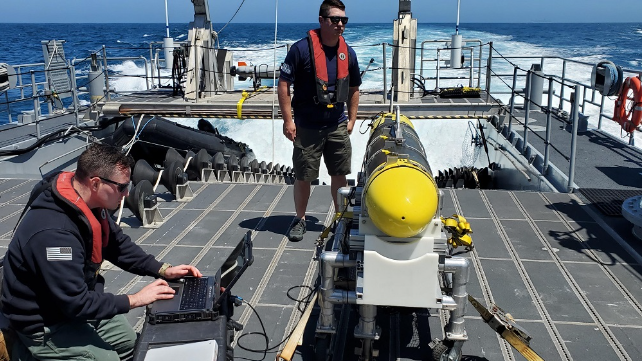USN: America's Potential Adversaries "Go All-in on Unmanned Platforms"

Chief of Naval Research Rear Adm. Lorin Selby today declared “the state of our Naval unmanned capabilities is truly unmatched,” and vowed continued support for the nation’s ongoing transition to a hybrid manned-unmanned force in the future.
Speaking during a visit to San Diego for the U.S. Pacific Fleet-led Unmanned Integrated Battle Problem 21 (IBP21), Selby said the exercise demonstrates that America’s growing focus on autonomous capabilities is showing impressive results.
“We are not yet where we want to be,” said Selby, “but we are getting closer. As our potential adversaries go all-in on unmanned platforms, we must and will maintain a dominant force that can meet and defeat any challenge.”
During the exercise, a large number of multi-domain unmanned platforms—including unmanned aerial, surface and underwater vehicles (UAVs, USVs and UUVs, respectively)—are being put into real-world, “blue-water” environments, working in sync with manned platforms in actual combat drills.
While many platforms in the exercise are classified, officials are highlighting the Medium Displacement Unmanned Surface Vehicles (MDUSV) Sea Hunter and its new sister craft, Sea Hawk, as well as a long-endurance UAS—all of which can be used for surveillance, anti-submarine warfare and other missions (below).
Sea Hunter is already a proven player in the Navy’s unmanned portfolio. In 2019, the vessel completed an autonomous trip from San Diego to Pearl Harbor, a distance of over 2,000 nautical miles, and returned, demonstrating credible and relevant naval capability.

Sea Hunter and Sea Hawk off San Diego, IBP 21, April 20 (USN)
The performance of many new unmanned technologies are leading the Navy and Marine Corps to rethink concepts of operations, as noted in the widely publicized naval document “Unmanned Campaign Framework,” which was recently released by the Department of the Navy. The Unmanned Campaign Framework notes autonomy will complement, not replace, manned assets, and will provide warfighters far more options in combat.
Dr. Marcus Tepaske, who leads ONR Global’s Experimentation and Analysis program, said these kinds of large-scale exercises are essential to ensure what works in theory will work in the fleet. “Real-world applications are messier, dirtier, wetter and absolutely more beneficial than anything we can test in a lab," Tepaske said.
Coordinating multi-domain manned and unmanned teaming efforts with so many different systems is in itself a daunting challenge. That job is being led by Pacific Fleet crews aboard USS Michael Monsoor (DDG-1001), one of three Zumwalt-class guided missile destroyers.
Ultimately, experts say, autonomous systems are here to stay. Dr. Jason Stack, ONR’s technical director and autonomy lead, says that ntelligent autonomous systems will be an essential part of the Navy and Marine Corps in the near-term.
“When you read the Unmanned Campaign Framework, the serious challenge we face from well-funded, highly-motivated, competitive naval forces around the world—all accelerating their autonomous capabilities—is clear,” he said.
Stack noted that the U.S. and allied partners have a more robust commitment to the ethical use of unmanned systems and artificial intelligence when compared to some other nations.
“Our goal is to operationally integrate and continuously improve the types of intelligent and autonomous technologies that Pacific Fleet is testing right now,” he said. “We will do this ethically and responsibly by always ensuring our sailors and Marines can exercise the appropriate levels of human judgement over our machines. This will be our enduring competitive advantage.”
The IBP21 exercise is the initial step in the Navy’s commitment to operational experimentation with autonomous systems in the fleet. Following its completion, the Navy and Marine Corps will assess what worked, what didn’t, and how to accelerate unmanned capabilities for the fleet and force.
This article appears courtesy of ONR and is reproduced here in an abbreviated form. The original may be found here.
The opinions expressed herein are the author's and not necessarily those of The Maritime Executive.

